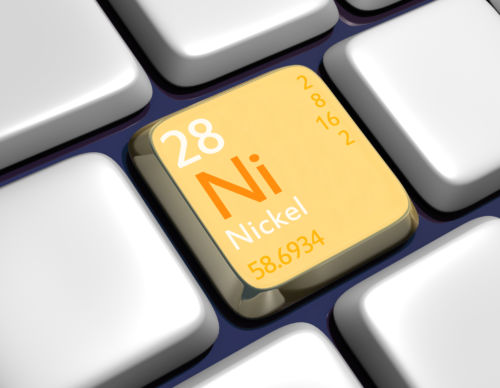Applications to Nickel
Calculate the following based on your actual alloy chemistry:
Application Examples
High Temperature Coating Degradation
Ni-based superalloys have excellent strength and creep resistance, but in many applications a protective coating is required for high temperature oxidation resistance. During service, the coating degrades mainly due to the interdiffusion between the coating and substrate. It is, therefore, important to be able to study the interdiffusion fluxes occurring between the coating and substrate in order to optimize the lifetime of the coating in a specific application.
This figure shows the interdiffusion between a NiAl coating on IN939 at 1050 °C after 96 hours simulated using the Diffusion Module (DICTRA). The calculation is compared to experimental data from E. Perez, T. Patterson and Y. Sohn, J. Phase Equilibria and Diffusion 27 (2006), pp. 659-64.

Variation in Solidus Temperature for Alloy 718
Understanding the melting temperature in Ni-base alloys is critical for casting, welding and additive processes. However, the melting temperature of an alloy can be sensitive to its actual chemistry. Handbooks and material data sheets typically only specify a nominal value for the melting range. Thermo-Calc can be used to explore the entire chemistry specification range and its effect on the liquidus and solidus temperatures.
This figure shows the variation in solidus temperature calculated for 1000 compositions that fall within the alloy 718 specification range. Similar diagrams can be calculated for other properties, such as γ′ solvus temperature or volume fraction of eutectic.

Young’s Modulus of CMSX-4 Superalloy
Elastic constants are necessary to model mechanical behavior of materials in service or during manufacturing (heat treatments). This helps describe different moduli such as Young’s modulus, which are dependent on the phase fraction at a given temperature.
In this example, the first plot shows the temperature dependent elastic property being used to calculate the Young’s modulus for a CMSX-4 superalloy used in gas turbine blade manufacturing. One of the main reasons this is possible is due to accurate prediction of gamma (FCC_L12) and gamma prime (FCC_L12#2) phases in these alloys as a function of temperature, as shown in the second plot. Experimental results from Epishin, 2021 show a reasonable fit for both cases. The calculation is made using the Nickel-based Superalloys Database and the Equilibrium with Freeze-in Temperature Model in the General Model Library.

Products Related to Nickel Alloys
Learn more about Applications to Ni-based Alloys
Implementing numerical algorithms to optimize the parameters in Kampmann–Wagner Numerical (KWN) precipitation models
Coupling TQ-Interface with Precipitation Models for Gas Turbine Applications
DICTRA used to model changes to Ni-based superalloy during Interdiffusion
Weldability of Nickel-based Alloys: Solving Problems with the Assistance of Computational Techniques
Application of finite element, phase-field, and CALPHAD-based methods to additive manufacturing of Ni-based superalloys
Design of an Eta-Phase Precipitation-Hardenable Nickel-Based Alloy with the Potential for Improved Creep Strength Above 1023 K (750 °C)
Effect of the Process Atmosphere Composition on Alloy 718 Produced by Laser Powder Bed Fusion
Modeling the precipitation processes and the formation of hierarchical microstructures in a single crystal high entropy superalloy
Thermodynamic and Kinetic Simulation of the Brazing Process Applied to Ni-Base Superalloys
Elevated temperature microstructure evolution of a medium-entropy CrCoNi superalloy containing Al,Ti
Computational design of a single crystal nickel-based superalloy with improved specific creep endurance at high temperature








